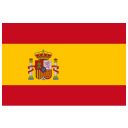The 11 Best (Some Are More Painful that Others) Tattoo Placement Ideas for Men
Publicado por PAUL PARK en

Though there are virtually no limits to where you can place a tattoo, it's crucial to choose your spot wisely. These are some of the more common places men are getting tattoos.
The concept of tattoo location entails determining the optimal place for your specific tattoo design and vision. Naturally, ideal locations may vary from person to person, as everyone has unique preferences. Ultimately, the best place for your tattoo is where you believe it will shine the most.
For men, certain locations offer a perfect canvas to exhibit their inked masterpieces.
11 Best Placement Ideas for Men's Tattoos
#1 Shoulder Tattoos
The shoulder (and whole arm generally) is an excellent location for tattoos, presenting a generous canvas for your ink without subjecting you to the intense pain associated with other tattoo sites. This area is particularly well-suited for circular or tribal designs, given its natural curvature and broad, flat surface. As the shoulder is a relatively steady part of the body — not prone to significant weight fluctuations or stretching — tattoos in this area tend to retain their shape and vibrancy over time.
Historically, shoulder tattoos have been highly popular across different cultures. Polynesian tribes, for example, have been known to utilize the shoulder area for intricate tribal tattoos as part of their cultural heritage. Such tattoos often carry symbolic meanings and are representative of an individual's status, achievement, or ancestry within the tribe. More recently, these designs have influenced modern tribal tattoos, with the shoulder serving as an ideal location for these bold, striking pieces.
Shoulder tattoos for men often carry a sense of carrying responsibilities or bearing burdens, alluding to the phrase "shouldering a load." These tattoos can symbolize protection, bravery, and strength.
#2 Upper Arm Tattoos
The upper arm, due to its stable skin and muscle tone, is a popular choice for tattoos. It provides a sizable, relatively flat surface for the artist to work on, making it a suitable canvas for a wide range of designs.
Historically, the upper arm has been a common location for tattoos across cultures. In ancient Rome and Greece, soldiers often bore tattoos on their upper arms to denote their unit or rank. Today, upper arm tattoos continue to be popular, often expanding into full sleeve designs that create an immersive, visual narrative.
Tattoos on the upper arm are traditionally associated with strength and masculinity. They can represent resilience, power, and courage. In some cultures, specific upper arm tattoo designs can also signify rank or status.
#3 Bicep Tattoos
Bicep tattoos offer a chance for the artist to showcase their work prominently, especially on clients who often wear short-sleeved shirts. The rounded contour of the bicep makes it perfect for creative designs that wrap around the arm. The skin here is typically healthy and well-suited for tattoos.
Historical examples of bicep tattoos are abundant. For instance, ancient Celtic warriors often bore intricate spiral or geometric tattoos on their biceps, believed to bestow the wearer with protection or strength in battle. This historical reference often fuels the modern trend of bicep tattoos, adding a deeper layer of meaning to these designs.
Arm tattoos for men often symbolize strength and power due to the association with muscular brawn. They can also reflect one's personal journey, with sleeve tattoos sometimes narrating a story or showcasing personal interests and values.
#4 Forearm Tattoos
Once considered unconventional due to their visibility, forearm tattoos have gained acceptance with the shifting perceptions of tattoos in workplaces and society at large. The distinctive structure of the forearm lends itself well to creative styling. Wrap-around designs, linework, and realism are just a few styles that thrive in this area.
In terms of history, forearm tattoos hold a significant place across various cultures. For instance, in traditional Polynesian society, both men and women bore intricate tattoos on their forearms, each design laden with symbolic meanings about their social status, skillsets, and lineage. Similarly, in the sailor culture of the 18th and 19th centuries, forearm tattoos were common, with specific designs symbolizing different experiences or milestones - the iconic 'anchor' tattoo, for instance, indicated a sailor who had crossed the Atlantic.
Forearm tattoos can symbolize both strength and determination, showing the world what drives a person and what they're passionate about. It can also be associated with skills or craft, as forearms are often used in various trades and arts.
Such historical and cultural significances continue to inspire the modern trend of forearm tattoos, making them a popular choice for both first-timers and tattoo enthusiasts alike. These pieces not only serve as a visible proclamation of one's individuality but also carry forward a rich legacy of tattooing traditions.

#5 Leg Tattoos
Legs, encompassing the thighs and calves, are increasingly popular locations for tattoos among men. These areas provide expansive, flat canvases that allow for large, intricate designs or a series of smaller, interconnected ones. Leg tattoos can be as bold or discreet as desired since they can be easily covered by clothing or exposed when wearing shorts or swimming trunks.
Historically, leg tattoos were quite prevalent in numerous cultures. Polynesian cultures often used the legs to showcase intricate tribal tattoos, which were not only aesthetically pleasing but held significant cultural and symbolic meanings. Likewise, in Japanese tattoo culture, the leg, specifically the thigh, was often utilized for large, detailed pieces of art as part of the traditional Irezumi style.
Leg tattoos can symbolize stability, foundation, and progress, as legs physically carry us forward in life. They can represent personal growth, journeys, and experiences.

#6 Thigh Tattoos
The thigh offers a broad, flat canvas that's ideal for large designs, and it's especially accommodating for designs that have a horizontal orientation. Moreover, the pain associated with thigh tattoos is typically less severe than other parts of the body, which can make the tattooing process more comfortable for clients. Tattoo artists often enjoy working on thigh pieces because the skin is typically smooth and firm, ensuring the designs retain their shape over time.
Thigh tattoos can symbolize mystery and allure, as they're typically concealed in daily life. They might represent personal secrets or private aspirations.
#7 Calf Tattoos
The calf, thanks to its naturally rounded shape, is perfect for circular or slightly oval designs. In the past, calf tattoos were quite popular among sailors, who often got tattoos of nautical themes or symbols of their travels inked on their calves. Today, the calf has become a favorite place for tattoos because of its visibility when wearing shorts and the ease with which it can be covered up. From an artist's perspective, the calf's stable skin, which is less prone to drastic changes in shape or size, makes it a reliable location for a tattoo that stands the test of time.
Like any other body part, however, the legs, thighs, and calves require thoughtful consideration for placement and design choice. These areas offer a lot of potential for creative designs, whether that means a single, impactful image, a sprawling scene, or a collection of smaller, interconnected tattoos.
Calf tattoos often symbolize agility and strength, given the calf's role in movement. They may represent one's determination to move forward in life, or personal achievements.

#8 Back Tattoos
With its expansive, unbroken canvas, the back is an ideal location for intricate and large-scale tattoos. Back tattoos tend to remain vibrant over time, due to the skin's thickness and resilience, along with limited sun exposure.
Historically, back tattoos have had significant cultural relevance. For instance, the Japanese 'irezumi' tradition often features full back tattoos, often depicting intricate scenes from nature, mythology, or traditional folklore. Today, such designs continue to inspire many large-scale back tattoos, creating captivating and detailed pieces of art.
#9 Hand and Finger Tattoos
Hand and finger tattoos are bold and highly visible, making them perfect for those who want to make a statement with their body art. Given the limited space, these areas are best suited for small, meaningful designs. Initials, symbols, or small pictorial tattoos are often seen adorning the hands and fingers. However, it's important to note that tattoos in these locations may require more frequent touch-ups, as the high-usage and constant exposure can lead to faster fading, not to mention the pain factor over bony areas.
Historically, hand and finger tattoos have played significant roles in various cultures. For instance, in some Native American cultures, hand tattoos were used to denote certain achievements or ranks within the tribe. In more recent times, celebrities like Rihanna and Ariana Grande have popularized finger tattoos, inspiring many to choose these prominent locations for their own small, meaningful designs.
Finger tattoos can symbolize a variety of things based on the specific finger chosen. For instance, tattoos on the ring finger often represent love, commitment, and relationships, while pinky finger tattoos might symbolize trust and friendship.
Hand tattoos are often associated with creativity, healing, and labor. They are also highly visible, symbolizing a fearlessness and open acceptance of one's identity and values.
Remember, the visibility of hand and finger tattoos can make them less ideal for those in conservative professions, but for those who wish to wear their stories on their sleeves (or rather, on their hands), they can be the perfect choice.

#10 Chest Tattoos
The chest is a versatile location for tattoos, providing a generous surface for large, elaborate designs. The skin on the chest is typically healthy and robust, with tattoos in this area retaining their vibrancy due to their limited exposure to sunlight. Prepping and tattooing on the chest is generally straightforward, though artists may need to accommodate for body hair.
Historically, chest tattoos have held significant cultural meanings across various societies. For instance, Maori men often had their chests and faces adorned with 'moko', a form of permanent body and face marking that communicated their genealogy, tribal affiliation, status, and achievements. More recently, many modern tattoos draw inspiration from such historical practices, with chest pieces seen as a bold and prominent display of one's identity or beliefs.
#11 Feet Tattoos
Feet tattoos can be an interesting choice for men who are seeking a unique placement that carries a deep symbolic significance. Often associated with stability, balance, and the journey of life, tattoos on feet can serve as personal reminders of the paths walked and the journeys yet to be undertaken. The designs can vary greatly, from small, subtle symbols to intricate patterns or quotes, providing a space for personal expression that's usually concealed, but can be revealed when desired.
The Maori of New Zealand, renowned for their unique "Ta Moko" tattoo art, often used foot tattoos as a mark of strength and courage. The feet, being more sensitive and painful to tattoo due to thin skin and proximity to bones, signified a warrior's endurance and resilience.
In Polynesian cultures, foot tattoos, often extending up to the calf and knee, were not just ornamental but contained specific symbolism. Given the maritime nature of Polynesian culture, foot tattoos often bore motifs of sea creatures, waves, and other ocean-related imagery, symbolizing a man's relationship with the sea, travel, and navigation.
The Native American tribes also had a tradition of foot tattoos. These tattoos often carried spiritual meanings, with symbols related to the earth and nature, signifying the person's connection to the earth and their journey through life.
Therefore, tattooing on feet in tribal cultures was not just a matter of aesthetic appeal. The placement held deep cultural, symbolic, and spiritual associations that reflected personal strength, spiritual beliefs, and cultural identity.
From a tattoo artist's perspective, feet, with their relatively flat surface, can be a great canvas for showcasing detailed art. However, tattooing feet might present some challenges due to the area's high bone density and thin skin. The process can be somewhat uncomfortable compared to other areas, and the tattoos may require more frequent touch-ups due to the high-wear nature of feet. Despite these factors, the unique placement and symbolic weight make foot tattoos a compelling choice for many men.

Summary
Choosing the right place for a tattoo is as personal and unique as the design itself. Whether it's the expansiveness of the back, the high visibility of the bicep, or the unique structure of the forearm, each location offers its own set of advantages and considerations. As tattoo artists, understanding these factors helps guide our clients towards the best placement for their desired designs. Each spot holds a rich history of tattoo tradition, offering not just a canvas for our artistry, but a testament to the enduring power and significance of tattoos in human culture. By exploring these top placements for men's tattoos, we continue to celebrate and innovate within this centuries-old art form.
For more information on our sets, please take a look at our piece on Xtreme Inks: Artist Collections.
TAGS:















